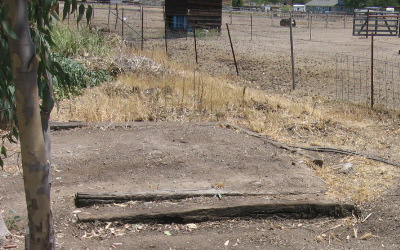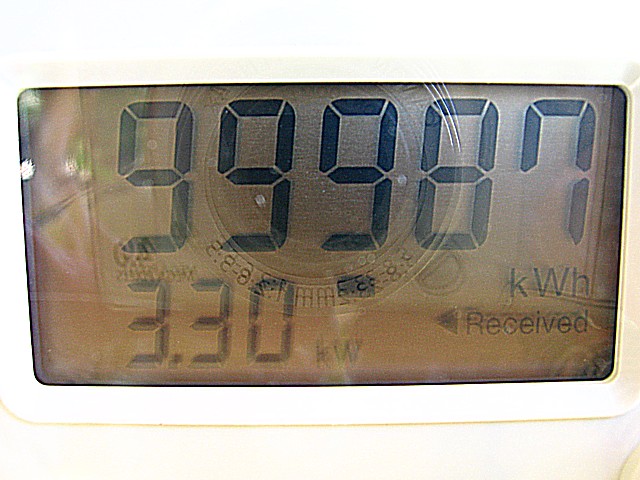|
|||||||||||||||||||||||
 |
|||||||||||
|
This page documents the installation of my solar panel system. I did the prep work in July 2007, and the system installation was done September 17-26, 2007. I had to start by clearing out the place where the panel system will be installed. It has to be no closer than 8' from the property line, and the panel plane will extend back 15 feet at a 30 degree angle. As you can see from the picture, there was a shed made from the top of an old pickup truck cap, a pile of very heavy railroad, two large dead shrubs and three small eucalyptus trees which weren't in the footprint of the system, but had to be removed due to a panel clearance rule from the power company. |
|||||||||||
|
It took me a couple of morning and evenings to get the site cleaned up. |
|||||||||||
 |
|||||||||||
|
On Monday, a day ahead of schedule, Mark and Matt rolled in with the truck to confirm the final layout and dig the holes for the concrete footings. The soil is so hard and full of rocks that they tried to dig by hand, then went to the hand-held gasoline auger, then called in for a Bobcat with a hydraulic auger, and that finally did the job. On Tuesday Darren and Matt mixed up the concrete and set the upright pipes in the footings. |
|||||||||||
|
On Thursday, John and Matt came in to measure the proper height and angle of the uprights, and cut them off. They then bolted on the horizontal frame members. |
|||||||||||
|
They then prepped the solar panels and since the company doesn't work on Friday, they will come back on Monday to mount them and start the wiring. Unfortunately one of the panel's frame was bent in shipping but the panel itself was undamaged. They took it back and will bring a good one. |
|||||||||||
|
On Monday Jeff showed up with a trench digger and ran a 2' deep trench from the corner of the rack to the workshop where they'll punch the cable through to the inverter. He cut through an unmarked plastic irrigation pipe but they'll fix that later. They'll also hand-dig near another water line and electric conduit. |
|||||||||||
|
On Tuesday, Jared and Sean worked on the electrical side while David and Thomas worked on the panel mounting and wiring. With the racks in place, they were able to quickly bolt on the support rails and then the panels. Building a 5000W system with 200W panels means 25 panels - and with a 3-row design, that means one has to be by itself at the end. |
|||||||||||
|
While that was going on, Jared was installing the inverter and the new breaker box as a subpanel to the existing panel in the shop. It turned out to be a lot less work and gave me all of the breaker capacity I could ever want. The yellow Romex wires are the new circuits I roughed in for my power tools, waiting for my electrician to do the final hookup. |
|||||||||||
|
They had to use a jackhammer to drive the grounding rod in because the ground is so hard. Due to the specification of the panels, they made up 5 strings of 5 panels each, and tied them together in this box. Each string has its own fuse. |
|||||||||||
|
They then pushed the DC cable through the conduit in the trench and hooked it into the inverter. |
|||||||||||
|
The County inspector came out and signed off on everything, so to run the test we flipped all the switches, the inverter booted up and my electric meter immediately started spinning backwards! I hooked up my data collection system, using the GT-View application to make sure the inverter data logging was working, and it checked out. While I wait for approval to go live, I'm working on my custom display application. |
|||||||||||
|
And here it is, my electric meter spinning backwards, 2 minutes after the test bootup of the system. The noise you hear isn't the meter - my neighbour chose to start up his chainsaw just then... |
|||||||||||
|
On October 2, a PG&E tech came to the house and swapped out the meter with this new bidirectional digital one. The panels were generating power, so it immediately wrapped around from 00000 to 99999 and beyond. The great thing about this meter is it indicates whether the meter is Receiving power from the property or Delivering power from the grid, and how much. As you can see from the display, the meter is receiving 3.30 kW from the property, which is the difference between the 4317 watts coming from the panels and the 1017 watts being consumed by everything in the house. I hope to never see the display get back over 00000 again! |
|||||||||||
 |
|||||||||||



















